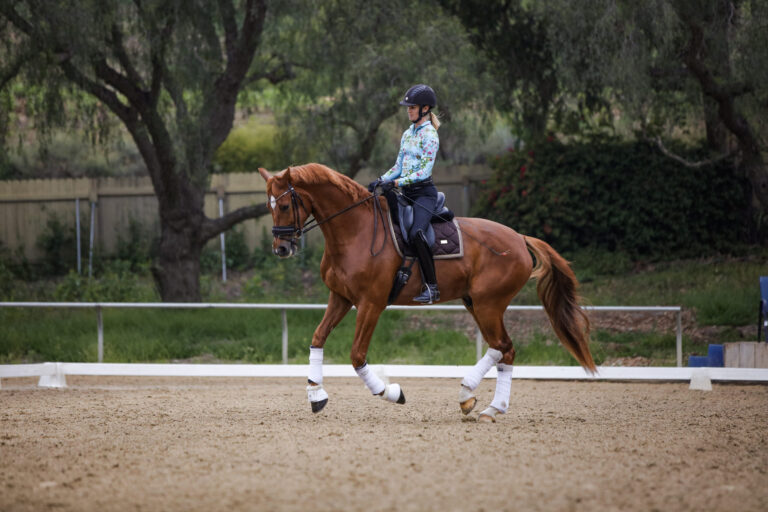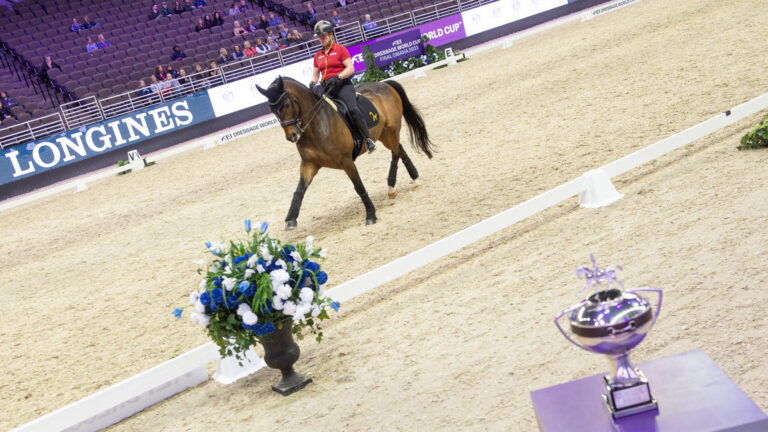Q: What effect does the rider’s upper leg have on the horse? Does it have a place in aiding, like the lower leg? —Lisa Schubert of San Antonio, Texas
A: One of the hallmarks of a classical dressage position is a long, flat thigh. This positioning of the thigh pulls the seat bones down into the saddle, creating a deep, connected seat and stability in the rider’s position. We find that there is a happy marriage of form and function in the dressage seat. The seat of the rider is composed of the pelvis, seat bones, lower back, lower abdominal muscles and the thighs. A skilled rider who has a secure, independent seat can create a tremendous amount of influence on the horse purely from her position and connection in her seat and upper legs.

Your upper leg, the thigh, starts at the hip flexor and runs downward toward your knee. Your thigh should lie flat against the saddle with a slight inward rotation of the femur. This position allows your hip joint to be flexible and take up the motion of the horse and, more importantly, stabilize your seat and balance on the horse. A long, flat thigh also opens up your seat bones, allowing you to sit deeply into the horse, and over a larger area in the saddle. Your knees are deep and relaxed and your weight down in your heel. When a correctly positioned rider is viewed from the side, her whole leg will lie flat against the horse in a relaxed way with the knees and toes pointing forward. In order to achieve this position, you must develop the ability to stretch the inner adductor muscles in your thigh. This takes time. Often we see riders who are tight in the adductor muscles, which prevents the seat bones from dropping down into the horse, consequently causing the hip flexors to stay too tight. Common mistakes are also gripping with the thighs and knees or going the opposite way and pushing the thighs and knees off the saddle, which locks the hip joints and destabilizes a rider’s seat.
Generally, the thighs influence the shoulders of the horse. The weight aid together with the upper leg influences the direction the horse’s shoulders are moving. To achieve the ability to guide your horse’s shoulders, lengthen your upper leg in a relaxed way but with positive muscle tone. There is a slight internal rotation of the thigh (combined with the weight down into your seat bones). When you use both seat bones, you channel the horse’s shoulders in the desired direction. When you use one seat bone and thigh on the same side, you turn or straighten the horse through the shoulder that is falling out. It would be incorrect to draw your knee or toe up or to stiffen your thigh and knee in order to influence your horse.
A second way the thigh can influence the horse is in speed control. In conjunction with your seat bones and weight aids, to slow your horse or to stop, slow the rhythm of your seat in a supple way and lengthen and firm the inner thigh. Depending on the intensity of the aid, this causes your horse to slow or stop.
A third way to use the influence of the seat and thigh is to balance the horse. Many horses have a tendency to drop their shoulders and withers. A balancing half halt for this situation would include the use of the seat, upper legs and upper body. The effect of this half halt would be to engage the horse’s hind legs and core while rebalancing the shoulders up.
In today’s world, we see many riders who are eager to move up the levels of training and showing, yet often neglect their seat and position. Dressage riding, however, starts with our position in the saddle. Our position is something we work on forever, every day. For example, use the initial 10 minutes of free walk at the beginning of each ride to give yourself a mini longe lesson. Some exercises to address the upper leg would be to alternate leg swings with your feet out of the stirrups, drawing the knees up in front of the pommel and gently pushing the heels back and down, and bicycling backward with the legs then finishing with the legs returning to a long, stretched position.
The last suggestion I would have for you is to spend a portion of your ride without stirrups. Five minutes a day can make a big improvement in your position and stability. This is the tried-and-true way to develop a deep seat and long, flat thigh.
A correct position with a long, flat thigh is attainable for every body type. I challenge all of you to devote five minutes a day of your ride to work on your upper leg. You will see and feel improvements within a few days. You will also notice a difference in your horse.

Sarah Geikie is an FEI 4* C dressage judge, a USEF “S” dressage judge, a USDF examiner and faculty member as well as a certified instructor through Fourth Level and a USDF bronze and silver medalist.











